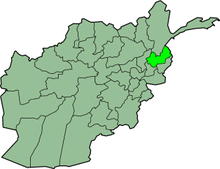Kafiristan
Kafiristan ( Persian کافرستان, DMG kāfiristān , 'land of the infidels') is the old name for the area around Nuristan , a province in northeastern Afghanistan . However, Kafiristan extended over a larger area than today's Nuristan and reached into the Pakistani Chitral district .
The borders of Kafiristan were never precisely defined due to the inaccessible location, but extended in the east to today's Pakistan . As long as there were no precise borders, the region was firmly in the hands of the Kafiri ( Nuristani ) and a center of anti-Islamic resistance. In 1893, however, after losing two Anglo-Afghan wars , the British Empire abandoned the attempt to annex Afghanistan to British India . With the Durand Line agreed at the time , there was an eastern border for a large part of Kafiristan for the first time. Abdur Rahman Khan took this opportunity and subjugated the rebellious kafirs until 1896.
religion
The indigenous polytheistic religion of the Kafirs, which had been practiced until then, visibly disappeared in the course of violent Islamization . The old religion includes a sky populated by gods and demons and cosmogonic myths that have some parallels in the Himalayan region. The supreme god, who is considered the creator god, is called Imra or Mara, depending on the region. Imra in the Kati language and Yamra in the Waigali language can be traced back to "Yamaraja", from which a connection to the Hindu death god Yama was established. Karl Jettmar suspects that the religion of the kafirs, in which old Iranian and old Hindu ideas are contained, essentially developed in the 1st millennium AD. In 870 AD the Muslim Saffarids conquered the city of Kabul . The centuries-long militant defense of the Muslim conquerors by the mountain peoples and their isolation are given as the reason for the religious special position of Kafiristan. Today the old religion is only practiced by the small Kalasha minority in the three valleys of Birir, Bumboret and Rumbur in the Chitral district in the far northwest of Pakistan.
The only distinct vocal polyphony in Central Asia belongs to the traditional culture of the kafirs . The chants are accompanied by the Waji bow harp , the two-stringed Sarindi fiddle (a regional variant of the Sarangi ) as well as drums and clapping of hands.
Geography, flora and fauna
(based on: Meyers Konversationslexikon 1888 )
Kafiristan, in the narrower sense a 12,950 km² landscape northeast of Kabul ; In a broader sense, collective name for the mountain states on the southern slope of the Hindu Kush , west of Kashmir , otherwise bounded by provinces of Afghanistan, 51,687 km² in size with around 500,000 inhabitants. Kafiristan is continuously an alpine country of great scenic beauty with a glaciated background in places. All rivers are tributaries of the Kabul . The longest, a huge mountain stream, is the Kunar, which flows into Jalalabad .
The climate is completely different from that of India and is generally temperate.
Rice and, in places, sugar cane thrive in the lower parts facing India, otherwise the slopes up to the summit are overgrown with trees, mostly coniferous wood. There are plane, fig, apple and pear trees in the valley. The grapevine is widely cultivated and beekeeping is widespread. Higher up follow mulberry trees, walnuts and grain; only near the main ridge of the mountain range crops no longer ripen. The fauna corresponds to the flora. Kafiristan is rich in game. The most rewarding pet is the thick-tailed sheep.
literature
- Karl Jettmar : The religions of the Hindu Kush . (The religions of mankind, volume 4.1) W. Kohlhammer, Stuttgart 1975, chapter: The religions of Kafiristan , pp. 29-185, ISBN 3-17-002092-7
- Maximilian Klimburg: The Kafirs of the Hindu Kush: Art and Society of the Waigal and Ashkun Kafirs. Franz Steiner, Stuttgart 1999, ISBN 978-3515063081
- Martin Voigt: Kafiristan. Attempt to study the country on the basis of a trip in 1928 . Hirt, Breslau 1933 (= Geographical Weekly; Supplement 2)
